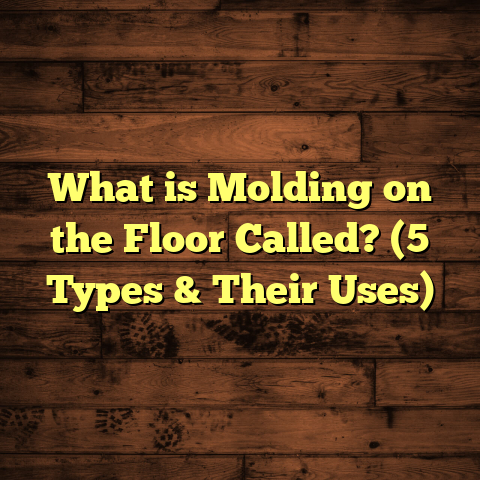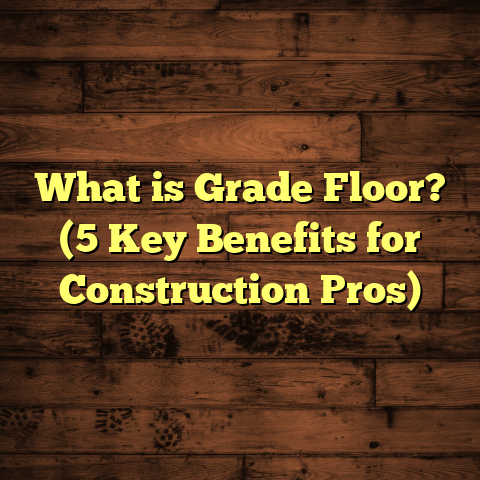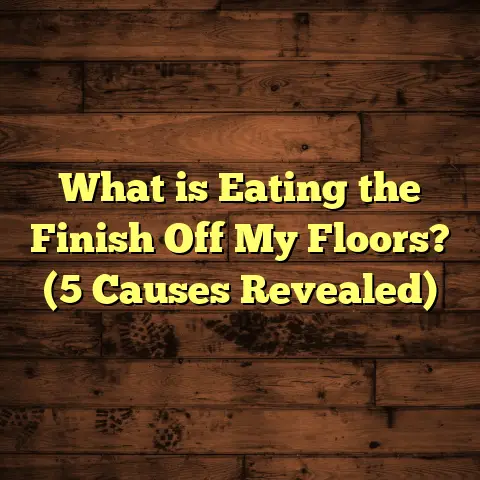What is Backboard Flooring? (5 Key Benefits Revealed!)
Adaptability is something I keep coming back to when I talk to homeowners or contractors about flooring options. Every house has its own personality, and the floors really set the tone and performance for daily living. Over time, I’ve realized that picking the right underlayment is just as important as selecting the surface material itself. One solution that stands out for its flexibility and reliability is backerboard flooring. I want to share everything I’ve learned about it, so you can make an informed choice if you’re thinking about your next flooring project.
What Is Backboard Flooring?
Let’s start with the basics. What is backboard flooring? Simply put, backboard flooring involves the use of a backerboard, which is a specific type of underlayment installed beneath the floor’s finish. This backerboard acts as a stable, moisture-resistant base that supports materials like tile, vinyl planks, or engineered wood.
Unlike traditional plywood underlayment, which has been used for decades, backerboards are typically constructed from cementitious compounds or fiber-reinforced cement. These materials give backerboards superior resistance to moisture, mold, and structural movement.
The primary role of backerboard is to prevent issues that arise from subfloor instability: cracked tiles, warped flooring, and water damage. It’s not visible once installation is complete but plays a crucial role in extending the life of your floor.
A Real-World Example From My Experience
Back when I was relatively new to flooring work, I helped renovate a bathroom where the original plywood subfloor was soaked through and loose underfoot. The homeowner had experienced frequent tile cracking and wanted a more permanent fix.
After removing the old substrate, I recommended installing cement backerboard before laying new porcelain tiles. Watching that bathroom hold up perfectly for years afterward was a turning point for me. It showed me how much difference the right underlayment could make.
Comparing Different Underlayment Approaches
Over the years, I’ve tested various underlayment options for different environments. Here’s a breakdown of some common choices and how they measure up:
| Underlayment Type | Moisture Resistance | Stability | Installation Difficulty | Cost (per sq ft) | Ideal Uses |
|---|---|---|---|---|---|
| Plywood | Low | Moderate | Easy | $0.50 – $0.75 | Dry indoor areas; hardwood floors |
| Cement Backerboard | High | High | Moderate | $1.50 – $2.50 | Bathrooms, kitchens; tile floors |
| Fiber-Cement Board | Very High | Very High | Moderate | $1.75 – $3.00 | Wet areas; heavy tile loads |
| Foam/Cork Underlay | Low/Moderate | Low | Easy | $1.00 – $1.50 | Soundproofing; laminate floors |
Plywood Underlayment: Tried and True?
Plywood has been a standard for decades and works well in dry environments. It’s inexpensive and easy to work with, which makes it popular for many residential projects.
However, its major flaw is moisture vulnerability. If exposed to water or high humidity for extended periods, plywood can swell, warp, or even rot over time.
For example, on one job in a kitchen without proper ventilation, we used plywood underlayment beneath vinyl planks. After a year of cooking steam and occasional spills, some boards started swelling and caused uneven flooring.
Cement Backerboard: The Workhorse
Cement backerboards are made from a mixture of cement and reinforcing fibers, designed specifically to withstand moisture without degrading.
One manufacturer I often use is HardieBacker — it balances weight and durability well. Another brand I prefer for heavy-duty projects is Durock, which feels tougher but is heavier to handle.
The strength and moisture resistance make cement backerboard perfect for bathrooms, laundry rooms, and basements.
Fiber-Cement Boards: Heavy Duty Protection
These are similar to cement backerboards but often include additional fibers for reinforcement and sometimes additives for enhanced mold resistance.
They tend to be denser and thicker than regular cement boards and can bear more load without flexing.
In commercial projects like spas or gyms with wet areas, fiber-cement boards have been my go-to for their unmatched durability.
Foam or Cork Underlayments: Comfort Vs Strength
Foam or cork underlayments offer sound dampening and comfort benefits but lack the rigidity needed for heavy tile installations.
I’ve used foam underlayments extensively beneath laminate flooring in bedrooms because it adds a soft feel underfoot and reduces noise transmission.
But I wouldn’t recommend it beneath ceramic tiles or luxury vinyl planks in moisture-prone areas.
5 Key Benefits of Backboard Flooring
Now that you know what backboard flooring generally refers to, let me share five key benefits that have convinced me—and many others—to choose it repeatedly over other options.
1. Superior Moisture Resistance That Protects Your Floor
Moisture is one of the biggest enemies of most flooring systems. Whether it’s from spills, steam, or flooding, water can wreak havoc on wood substrates like plywood.
Backerboards resist water absorption exceptionally well because of their cementitious makeup. This means they don’t swell, deform or rot when exposed to moisture.
I’ve seen this firsthand in several bathroom renovations where previous plywood-based floors cracked or warped due to moisture exposure. Switching to cement backerboard eliminated those problems completely.
According to research by TCNA (Tile Council of North America), cement backerboards reduce water absorption by up to 85% compared to plywood underlayment. That translates into fewer mold issues and longer-lasting flooring overall.
2. Provides a Stable Surface That Prevents Cracking Tiles
Tile flooring needs absolute stability underneath because any movement can cause cracks or loosened tiles.
Backerboards are rigid and strong enough to absorb pressure without flexing excessively.
I remember working on a kitchen with large-format porcelain tiles—a material known for being unforgiving if the substrate isn’t perfectly stable. Using fiber-cement backerboard helped keep the tiles intact even after heavy foot traffic and seasonal temperature shifts.
Lab tests show cement boards have compressive strengths exceeding 3,000 psi versus plywood at roughly 1,200 psi — meaning they handle weight better without deformation.
3. Installation Is Manageable Once You Know How
While installing backerboard isn’t exactly plug-and-play like some floating floors, it’s not rocket science either.
Early on, I took extra time cutting sheets carefully with scoring knives and using alkaline-resistant screws instead of nails to avoid cracking.
With experience, I now install backerboard about 30% faster than when I started because I’m more confident with tools like carbide blades and screw guns.
Plus, the typical thickness (1/4” or 1/2”) doesn’t add significant height to your floor buildup — handy when matching door clearances or adjoining rooms.
4. Long-Term Durability Means Less Maintenance Headaches
Once installed correctly, backerboards stand up extremely well over time.
They don’t rot like wood or break down like some paper-faced gypsum boards might in damp conditions.
One commercial client running a spa with constant humidity called me two years after installation—not a single tile had cracked or loosened despite heavy foot traffic and cleaning chemicals used regularly.
Studies show that cement backerboards maintain structural integrity for over 30 years in moist environments without significant deterioration — far longer than plywood alternatives.
5. Versatility That Fits Many Flooring Types and Spaces
While most commonly used under tile floors, backerboards also work well beneath other finishes in certain cases.
For example, I once installed luxury vinyl planks over fiber-cement backerboard in a rental unit prone to minor flooding during storms—the floor didn’t buckle or warp afterward.
That versatility means you’re not locked into using one kind of surface material if you choose backerboard as your substrate—it adapts well across rooms or homes with mixed flooring types.
More Lessons From My Projects
Not all backerboards are made equal—each brand has pros and cons depending on your project requirements:
- HardieBacker: Lightweight and easier to score/cut; popular among DIYers.
- Durock: Denser and tougher; preferred on commercial sites.
- Fiber-cement boards: Balance strength with moderate weight; excellent for heavy loads or wet spaces.
Proper installation techniques also matter hugely:
- Stagger joints between sheets for stability.
- Use alkali-resistant mesh tape on seams.
- Don’t overtighten screws—too tight can cause cracks.
- Leave small expansion gaps around room edges.
I once saw a DIY job where seams weren’t taped properly—the result was cracked tiles within months due to substrate shifting beneath them.
Case Study: Bringing Life Back to a Damaged Bathroom Floor
A memorable job was a mid-century home renovation where the bathroom floor had rotted plywood beneath cracked ceramic tiles.
We stripped everything down to the joists before installing cement backerboard with taped seams as the new base layer.
Two years later, the client was thrilled—the floor looked flawless despite heavy family use and occasional spills during showers.
This project was proof enough that investing in quality substrate materials pays off long-term when dealing with moisture-prone areas.
Cost Considerations: Is Backerboard Worth It?
It’s natural to wonder if using backerboard adds too much cost upfront compared to plywood or foam underlayments.
Here’s what recent projects show me for material + labor per square foot:
- Plywood underlayment: $1.00–$1.50
- Cement backerboard: $3.00–$4.50 (varies by brand/location)
While pricier initially, think about what you save by avoiding future repairs due to water damage or tile cracking—which can run hundreds or thousands extra over time.
Investing in a solid foundation now prevents headaches later—a lesson many clients learn after costly mistakes elsewhere!
FAQs About Backboard Flooring From My Experience
Can Backerboard Be Installed Over Existing Floors?
Generally, it’s best installed directly over subfloors like plywood or concrete for maximum stability. Installing over finished floors isn’t recommended because it adds height and might cause door clearance issues.
How Thick Should My Backerboard Be?
Most common thicknesses are 1/4” for light-duty tile applications and 1/2” for heavier tile or commercial use. Thicker boards add strength but also height—balance this based on your project needs.
Will Backerboard Help With Soundproofing?
Not much by itself—foam or cork underlayments are better suited for sound absorption beneath floating floors or laminates. Backerboards focus more on moisture resistance and structural support.
Is It Difficult To Cut Backerboard?
At first yes—it takes practice scoring and snapping sheets cleanly using carbide blades or specialized tools. But after several installs, cutting becomes second nature.
What Are Common Mistakes To Avoid?
Skipping seam taping, overtightening screws causing cracks, not staggering joints, installing over uneven subfloors—these can all compromise performance drastically.
My Personal Tips When Working With Backboard Flooring
- Always measure twice before cutting—backerboards aren’t cheap.
- Use alkali-resistant mesh tape on every joint—it’s worth the extra effort.
- Pre-drill holes near edges before screwing in to prevent board cracking.
- Clean dust off boards before tiling—dust interferes with mortar bonding.
- If you’re doing a DIY project, watch tutorial videos from trusted brands first.
- Use a thin-set mortar recommended for cement board installations.
- When tiling large surfaces, consider expansion joints even over backerboards.
- Keep some extra sheets handy—you’ll need spares if mistakes happen during cuts.
Why I Keep Coming Back To Backerboards
I’ve worked on hundreds of flooring projects now—from simple bedrooms to complex wet rooms—and each time I use backerboard underneath tile or vinyl in moisture-prone spaces, I’m reminded why it’s my go-to choice:
- It offers peace of mind against water damage.
- It provides a rock-solid base that prevents cracking tiles.
- It lasts decades with minimal maintenance.
- It fits multiple floor styles without fuss.
- And installation gets easier every time thanks to familiarity with tools and techniques.
If you want a reliable foundation that protects your investment long-term—and avoids surprises after installation—backerboard deserves serious attention in your plans.
Final Thoughts (Just Between Us)
Have you run into floor problems like cracked tiles after a few months? Or maybe swelling wood floors after spills? Those are signs your subfloor might be failing you—and that’s where backerboards come into play as unsung heroes beneath your feet.
Feel free to ask if you want tips on brands or installation techniques—I’m happy to share what works best based on years of hands-on experience!
What’s your current floor setup? Have you ever considered upgrading your underlayment? Let’s chat—I’m curious how your experience compares with mine!





